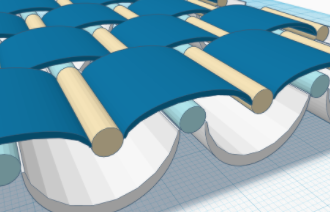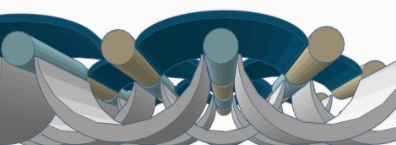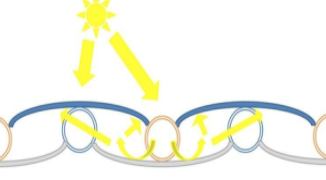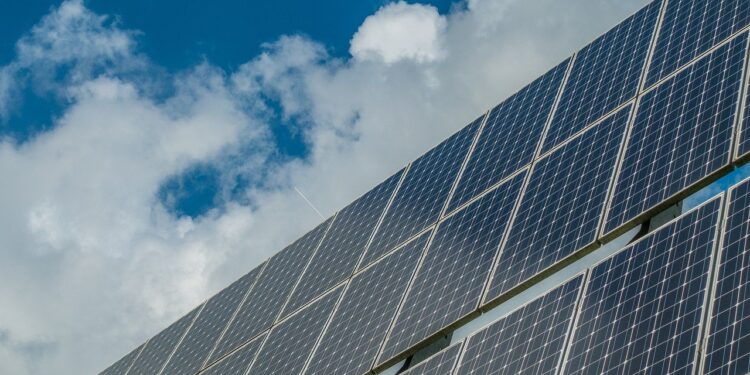Conventional solar panels have been designed and used to convert solar radiation into electricity with a mono-facial. However, it presents low energy conversion efficiency and high cost because it can absorb light just via one side. In order to reduce the cost of solar power generation, Bifacial PV panel has been proposed in this patent (US3278811A). It can potentially decrease the cost of generated electricity, because this solar cell type can convert incident sunlight to electrical energy from both sides of the cell. Cuevas et al. have demonstrated bifacial modules with 50% more electric power generation by collecting albedo radiation from the rooftop and the surroundings. Thus, bifacial solar cells not only increase the power density, but could also reduce the area-related cost for a (PV) power system. Moreover, Bifacial crystalline silicon solar panel with a reflector has been proposed in this patent (US9379269B2) to absorb more light by the backside of the panel. On the other hand, an increase in temperature causes a reduction in the band gap. This in turn, causes a decrease in energy conversion efficiency. Therefore, it is beneficial to apply artificial cooling to PV modules for the improvement in power output and optimum performance, Various methods have been applied for this specific purpose. Nevertheless, to the authors’ best knowledge, no reference has been found in the literature that presents a PV panel which combines the two solutions, cooling and bifacial with reflector. Therefore, this work presents improved design of the integrated a bifacial solar panel that converts solar radiation efficiently into electrical energy with a cooling system.
The aim of the present concept is to provide a solar panel that can convert solar radiation into electrical energy with the following features: 1) The decrease of the temperature of the photovoltaic. 2) Convert incident sunlight to electrical energy from both sides of the cell with the help of mirrors. 3) Reducing the area-related cost for a photovoltaic power system. It should be mentioned that the proposed concept is registered as patent application at OMPIC (Office marocain de la propriété industrielle et commerciale) under the following number: MA42181B1 by Badre El Majid, Saad Motahhir and Abdelaziz El Ghzizal.
DESIGN CONCEPT
As shown in Figure 1, the purpose of the concept is to provide a bifacial solar panel that doubles the surfaces exposed to solar radiation in order to produce more electrical energy. The material that passes through the tubes is used to cool the photovoltaic device, as well as, it should be transparent to let the solar ray pass to the reflective mirrors and reflect it in the backside of the panel. In can be noticed that the system uses parabolic bifacial PV cells that are connected to each other using tubes. The reason behind using parabolic PV cell in order to reduce the area-related cost of a PV power system. Note that bifacial polymer PV cells are required to build the proposed system.


Figures 1 and 2 show the purpose of the transparent conductive tubes, there are two types of tubes (yellow and blue), which are used to connect the PV cells with each other as follows:
The yellow tube is used to connect the PV cells and build a PV string horizontally.
The blue tubes are used to connect the PV strings vertically. Each string is connected to the other with a shift of ½ from the adjacent PV cell by connecting the yellow tube of each string with the blue tube of the other string. The shift is made alternatively once towards the down area and once to the up part. Note that the blue tubes are fixed in the middle of the PV cell’s backside. The tubes (yellow and blue) are filled in with a material that can cool the PV cell in the middle (blue tubes) or in the extremities (yellow tubes). As a result, this procedure improves the efficiency of the PV panel. It is important to note that the material of the blue tubes is not fused with that of the yellow tubes, in order to avoid the temperature increase of the blue tubes by the material of the yellow tubes which is exposed to the sun.
As shown in figure 3, the parabolic form of PV cells and the alternative connection of PV strings, allow leakage of solar radiation to the mirror through all holes resulted by this conception. Furthermore, since the material and the tube are transparent, this is allowing also the leakage of solar radiation to the mirror through the yellow tubes. Hence, the proposed system can convert incident sunlight to electrical energy from both sides of the cell and generating more electric power collecting the maximum of radiation.

Challenges
On the basis of the promising findings presented in this invention, work on the remaining issues is continuing and will be presented in future works as follows:
- Determining the appropriate material to be used for transparent tubes. It must be able to cool effectively the proposed system and it must be transparent. For instance, in a recent paper with the following DOI (10.1016/j.jclepro.2018.04.057), phase change material has been used to cool a PV panel. However, it is not transparent.
- Bifacial polymer PV cells are required to build the proposed system. Therefore, it is mandatory to start by looking for this kind of PV cells.
- Modeling the proposed system using simulation tools like Matlab/Simulink.
- choosing the nominal parabolic degree to maximize the PV efficiency
- For instance, the efficiency of mono-facial PV panel is computed by the following equation:

Here, I(t) is the light intensity which may be defined as irradiance (E), i.e. the power of electromagnetic radiation per unit area incident on a surface and A is the surface area of silicon solar cell. Therefore, it is required to model an equation which can be used to compute the efficiency of the proposed system.
The Solar cell efficiency temperature dependence is modeled by the following equation for mono-facial PV panel:

Here, ηc and ηTref are efficiencies of the solar cell at cell temperature and room temperature respectively, β0 is the efficiency temperature coefficient (0.004K−1), Tc and Tref are the cell temperature and reference temperature of solar cell respectively. The quantity (Tc−Tref) increases with cell temperature and consequently, the efficiency of mono-facial PV panel decreases. Therefore, it is also required to model the c Solar cell efficiency temperature dependence of the proposed system.
6.The most challenging task is Building the first prototype of the proposed system. Then compute the efficiency of the proposed system and compare it with existing PV panels.
CONCLUSION
From the concept that has been carried out, it is possible to draw the following conclusions:
- The proposed concept of parabolic bifacial solar panel, allow recovering the maximum of solar energy on a reduced area with the cooling system. Hence, this may ensure the enhancement of the energy conversion efficiency.
- Reducing the area-related cost for a photovoltaic power system.
- Several other questions remain to be addressed as “will this concept be more efficient compared to existing PV panels?”. Therefore, more research into the challenges mentioned in section 3 is still necessary before obtaining a definitive answer to these questions. Hence, leading a new way which may result in more compact and efficient PV energy.
Link to the patent: https://worldwide.espacenet.com/patent/search/family/068426003/publication/MA42181B1?q=motahhir
Author: Saad Motahhir (ENSA, SMBA University, Fez, Morocco)
































